|
|
|
|||
|
|
||||
|
|
||||
| Smoke Trails | ||||
|
|
HOME | SITE MAP | FORUM | CONTACT |
|
||
|
ABOUT | MOTORS | MODELS | ARCHIVE | HISTORY | STORE | FAQ | LINKS
|
|
|
|
|
|
||||||||||||||||||||||||||||||||||||||||||||||||||||||||||||||||||||||||||||||||||||||||||||||||||||||||||||||||||||||||||||||||||||||||
|
Smoke Trails 14
(February 2008)
by Roger Simmonds Adapted from a column originally published in SAM 35 Speaks, February 2008 I trust everyone is busy with their winter building program. The choice of ‘jet’ models appears to be greater than ever before, with some with new ‘classic Jetex’ kits from the Skyleada range being produced by A&DB Models (ADBModelAircraft.com). These include the Canberra, Vulcan and Skyray for Jetex 100, and the Cutlass, Mystère IV and (uniquely) Gnat for Jetex 50. Alan Briggs of A&DB, and Pauline Hook of Flitehook hope they will be available soon. If they are of equal quality to the FROG kits A&DB also produce, they will be worth waiting for! |
|
||||||||||||||||||||||||||||||||||||||||||||||||||||||||||||||||||||||||||||||||||||||||||||||||||||||||||||||||||||||||||||||||||||||||
|
I’ve been enjoying my collection of Alex Imrie’s ‘Vintage Corners’. In truth, there is not all that much on rocket power, but the illustration (right), which appeared in Alex’s appreciation of the legendary Dutch modeller Juste Van Hutton (VC, Jan ’90) is priceless and vaguely topical. Returning to the subject of interesting websites, two definitely worth a look at are FiddlersGreen.net, devoted to paper models, including some very tasty jets, and Zoe Quilter’s FuelSoaked.me.uk, devoted to C/L. Zoe is also reproducing 1950s Model Aircrafts and Aeromodellers month by month. I filched this nice 1956 ‘Wimco Hollows’ advert’ (below right) from last November’s update. According to this Sebel advertisement, a Hunter and a Vulcan would be “Coming soon”. The latter especially would be a most desirable object – but, given the tooling difficulties Bert Judge had with these kits (the range did not survive very long after Sebel took over), I wonder if either reached the shops. EBay also continues to surprise with unusual Jetex memorabilia. The Nordic X-15 (bottom left) was recently auctioned by Dick Westerink of Toysowhat [sic]. Now I had previously assumed that the X-15 featured in Isacson’s catalogues was the imported Jetex ‘Tailored’ model, which had moulded fuselage shells and was powered by an Atom 35 (see (Jet) X Files 10 and 13). This is quite wrong: Isacson’s model is indigenous to Sweden – note his characteristic logo and the ‘Robot’ trademark, and the box art is red, not ‘Jetex’ yellow. Curiously, the prefabricated contents are also bright red and not the expected black. As far as one can tell, these are printed balsa sheet and are not pre-shaped. Andy Blackwell thought the model was a “not very interesting ‘slice 'n' fold’ semi-profile” model and declined to bid. Hmm … Sten Persson had also spotted this one, commenting: “It is one of Isacson's later kits, and made its first appearance in his 1960 catalogue. It is quite intriguing that one has ended up in Holland! It seems to be in good condition but I'd hesitate to pay $50 or more for it, especially as a rare example of the Sebel Lynx went for less than $100 not so long ago, which is amazing considering that some Keil Kraft kits can fetch almost as much as that.” I thought this X-15 appeared much more interesting than either Andy or Sten thought, especially after Dick had kindly sent me a copy of the ‘plan’ (below), which makes the unusual method of construction perfectly clear. Unfortunately, as the kit is extensively prefabricated, the plan doesn’t reproduce the die cut parts – a great pity and an all but insurmountable obstacle to replication. 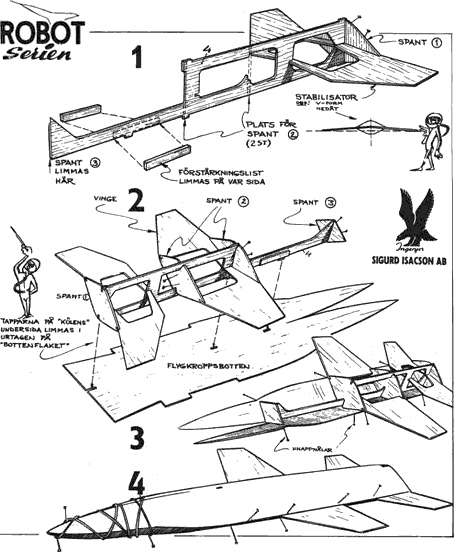 As is usual with Isacson’s products, the plan is liberally annotated with co-designer Bjorn Karlstrom’s delightful little figures. In this instance, and as befits the subject, some are in pressure suits. The finished model, though ‘stand well off’ scale, is more than a ‘semi-profile’ model and would appear in looks broadly comparable to the roughly contemporaneous Sebel model. It should look good in the air despite the exposed motor – a slimmer (and lighter) Rapier would be a better and less apparent means of propulsion. So all we need to replicate this little beauty are photocopies of the appropriate bits of wood, but these may be difficult to get hold of from a dealer as opposed to a genuine enthusiast. |
 Van's Christmas card from 1950. The healthy ‘jet infant’ shows the changing trend then taking place in aeronautics
- reprinted Aeromodeller, Jan. 1990
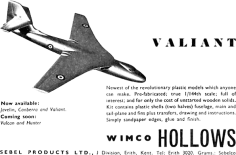 Wimco Hollows Valiant
- Aeromodeller, ? 1956
 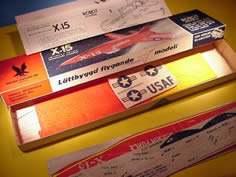
- Dick Westerink (eBay/toysowhat)
(Above, below and left) Sigurd Isacson's X-15 for Jetex 50. Though superficially similar to the Sebel X-15, it is an independent, and perhaps earlier, design. The Sebel product, it will be remembered, had a moulded cardboard body and was powered by an Atom 35. The construction of Isacson's Jetex 50B powered model is all-wood model is possibly unique and doesn't look particularly easy! 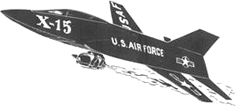
- Isacson catalogue, 1960

- Jetex/Sebel X-15 plan (detail)
Construction of the Jetex X-15 for comparison. There are similarities, but the fuselage shells, which are conveniently fully moulded for easy construction, are attached from each side, not top to bottom |
||||||||||||||||||||||||||||||||||||||||||||||||||||||||||||||||||||||||||||||||||||||||||||||||||||||||||||||||||||||||||||||||||||||||
|
|
|
|||
Whilst we’re on the subject of X-15s, Steve Bage made a most interesting version last year. I’ll let Steve describe his innovative model in his own words: “I thought how nice it would be to be able to put a Rapier motor in the scale position in a model, thereby dispensing with the need for an ugly trough or heavy augmenter tube. Of course, there is a good reason no one does it that way, as in all but a few aircraft putting the Jetex/Rapier motor in the scale exhaust location will put it way behind the CG and there would be an unacceptable change in trim as the propellant burns off – the model would be tail-heavy at launch and nose heavy after the motor is exhausted. “First I thought of having some sort of moving counterweight controlled by a clockwork timer or a rotary viscous ‘button’ that would offset the reducing propellant mass, but this looked to be quite a complex and heavy solution. I then I thought about using extreme downthrust to offset the rearward CG, as Howard Boys used on his Vampire and Swallow models of 1947. In these designs the motor was only slightly behind the CG, and Howard could get away with a fixed ‘downthrust’ angle. But I had in mind an X-15 model which would put the motor much further behind the CG, so I figured some form of variable thrust offset would be in order, with the idea that the changing propellant mass would be balanced by the changing downthrust. |
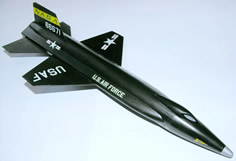 Steve Bage’s experimental true-scale X-15. Note the rear mounted Rapier L2
- Steve Bage
|
|||
|
“I came up with a pivoted motor mount that could rotate by an angle of about 15 degrees [see photos right]. A wire spring provided the driving force and a small viscous rotary damper provided the control. Optimising the spring force and pulley diameters to get the motor to rotate through the desired angle in about 20 seconds (the average burn time of a Rapier L2) took a great deal of trial and error, but I got there eventually. The X-15 itself was all sheet construction with a rolled fuselage formed from very light “Test flying proved a little frustrating. The model was initially trimmed by catapult launch and behaved a conventional way despite the radical layout. Power flying was, however, quite another matter, as the variable downthrust proved more sensitive than I expected. Early flights with the full 15 deg downthrust had the model diving into the ground directly from launch; relaunching by hand sometimes gave a longer flight, usually with a couple of loops toward the end of the power run as the motor returned to zero downthrust configuration. “Adjusting the motor angle to give less initial downthrust proved tricky to get right; a fraction too much and the model dived into the ground, too little and it just flipped over on its back and tumbled to the ground. I did achieve a few reasonably successful flights, but eventually I decided that these few good flights were costing me too much in wasted motors, So I took out the fancy motor mounting and glued an L1 motor mount to the belly [in the conventional position]. The model then performed quite well, but was a little underpowered with the latest (and very weak) 50mN motors. Once I get my hands on some better L1 motors the X-15 will be flown again – I’m hopeful of some good flights on 2008.” Thank you Steve. I have seen a video of this ambitious model in flight, and it is not for the faint-hearted, at least in its initial guise! Ask Steve if you would like a copy of the plan. Some Flaky Discussions |
 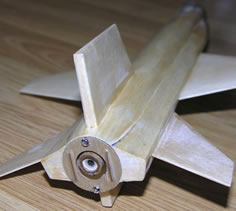 Steve Bage’s experimental X-15 – detail of the rear mounted Rapier L2
- Steve Bage
|
|||
|
John O’Donnell is no doubt right when he says that competition for rocket-propelled duration models is moribund, but an ‘International Competition’ to be held at Eloy in the US, in memory of the late Carlo Godel, has stimulated quite a lot of interest. Any model can be entered and flown, if necessary by proxy, but all must be powered by a Rapier L1. Howard Metcalfe came up with a new and very potent new ‘QT’ design made of d*pr*n, but, excitingly for every SAM reactionary, not a few competitors elected to build versions of old designs; for example Ian Dowsett’s Arrow 50 or Bill Dean’s Spook, and Steve Bage has made a Snowflake and Mike Stuart a Keilkraft Spacejet (see photos of original box art right). Of these, the Snowflake is perhaps most interesting, and Steve’s model stimulated some discussion on the (blessedly reborn) Jetex.org Forum about the modifications necessary to compensate for a lighter motor that has less thrust than even a very clapped-out Atom 35.  |
 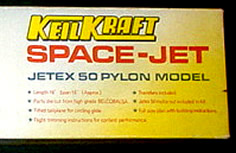 Keilkraft Spacejet box art (details)
- Ken Butterfield
|
|||
|
Though published in Aeromodeller, November 1960, Ron Armstrong’s model (above and right) was actually designed in 1954, and won the BMFA, er, S.M.A.E. Jetex Cup in 1957. Steve’s ‘Snowflake II’ (below) has a span of 14" (as opposed to the original’s 15  |
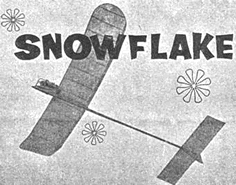 Ron Armstrong's Snowflake (des. 1954)
- Aeromodeller, Nov. 1960
|
|||
|
Steve writes: “It needed 0.8g on the nose. Test flights showed a much stronger climb [than a previous heavier model] but due to the higher power/weight ratio, getting the trim just right was a little trickier. Once properly trimmed this model appears capable of about 80 seconds in dead air, which is not bad with only about 50 mN of thrust available. “Even if I'd built the original (full size) Snowflake for an L2, the model would still have been at least 6.3g lighter; it would need to be scaled up to about 18", otherwise it could be a little ‘wild’.” These comments touch on a topic previously discussed in these columns: the sometimes spectacular performance of classic designs when relieved of the weight of a metal-bodied motor. It will be remembered that a Jetex 50C weighed about 9g empty and 15g loaded; an unused Rapier L1 weighs 4.8g and less than half that when exhausted. Steve now thinks that perhaps he should not have reduced the Snowflake. Commenting on this and the stratagem of moving the Rapier forward to reduce the need for nose weight, he writes, “I would have had to move the Rapier a couple of inches further forward to enable the removal of the 0.8g noseweight, but I would have ended up with a motor located much further from the CG than the original Jetex model. “Jetex models, in the majority of cases, are trimmed for glide with an empty motor case and the fact that for the first few seconds of powered flight the CG is forward of its glide position. A key difference between the Jetex and Rapiers is that Rapier propellant weighs more than the case, whereas with a Jetex the case is twice as heavy as the fuel, so the proportional change in weight of the Rapier during flight is much larger as the fuel burns. Couple this with a motor that's located much further from the CG than the original Jetex model and you have a much, much greater change in trim than the original Jetex model ever experienced. This change in trim over the motor run is something I experienced quite clearly with my early scale models, which is why I put the motor as close to the CG as possible on the Snowflake. Many people complain of Rapier and Jetex models looping during the final phase of the power run – without exception the models that do this have the motors located well forward.” |
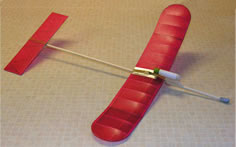 Steve Bage’s Snowflake II for Rapier L1 13" span, 5.7g without motor
- Steve Bage
|
|||
|
Mike Stuart has had many good flights with his L2 powered Spacejet (right), but he was less than sanguine about his reduced version for L1, writing: “I got it flying in gentle right hand circuits once I had added a couple of trim tabs to stop it spiralling in to the right (the wing is not quite flat). In retrospect this model was a bad choice for the competition, and with the 60 mN motors I was using, the climb out was very disappointing, with a best flight of only about 40 seconds. The problem is that the original was designed to have a Jetex 50 at the front providing most of the noseweight. Thus the nose is very short and the tailboom very long. This means you need a ton of noseweight when you power it with a much lighter Rapier. My airframe weight is 10 grams, which is fine, but I then needed another 6.5 grams of lead shot in Blu Tack on the nose to get the balance point and glide OK. With a weight of 16.5g without motor, a low power L1 is just not going to get it much above head height. The solution would be to design a ‘Space Jet Type R’ with a much longer nose. Less weight would then be needed to balance the model. However, it should fly quite well on the boxes of 75 and 80 mN rated L1s that I still have. These will give me a reasonable power to weight ratio.” All of the above is good advice (that I’m happy to give away) from two of the masters of the art, and should be born in mind when building that Min-O-Jet or Skyjet if a predictable performance is desired. My only comment is that I deliberately built my L2 powered F.D.2 with a forward motor so that it could cavort about once it had climbed steadily to height. It seemed to work, and I’ve got videos to prove it, but then perhaps neither the model nor I knew any better at that time, or the delta planform and wing section I chose had something to do with it. For a less exciting and more predictable life, if you put the nozzle of the Rapier on the CG to start with you won’t go far wrong. |
 Mike Stuart’s reduced KK Spacejet 14" span, 16.5g without motor
- Mike Stuart
|
|||
This month’s plan is Don Monson’s unusual profile F-102 that appeared in Model Airplane News, August 1959 (right and below). It is a model, I would suggest, suitable for experiments in the position of the motor. And if you are wondering why it is unusual, have a look at the wing leading edge. Detail of this ‘conical camber’, which reproduces that of the full size Delta Dart, is shown below. 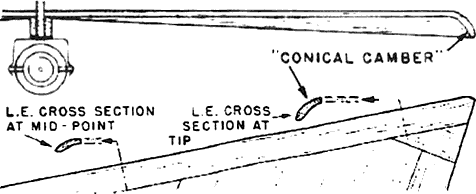 Returning to the L1 duration competition: the rules, which are based on the old AMA Jetex event, are available on the Jetex.org site. Six attempts are allowed for three flights with a 2 min max; a fourth flight, where necessary, is unlimited. An interesting (and perhaps necessary) feature of the competition is that the organisers will provide all the motors, which will (hopefully) all be from the same batch. Ignition will be electronic. The L1 has, at least until now, been the most reliable and relatively immune to the dreaded bursting malaise. However, there have been rumours that the latest batches are low powered and difficult to light with the supplied fuses, even with extensive reaming. Electronic ignition should overcome this, but they also have a tendency (according to one US correspondent) to “phut, sputter, splutter and burp” and go out with a distinct ‘pop’. This is worrying – with relights there is always the possibility of different motor runs, and of inconsistent thrusts if the nozzles are opened up in the process. This could complicate the competition no end. Be assured I will report the results, and any interesting discussions arising therefrom, in due course. |
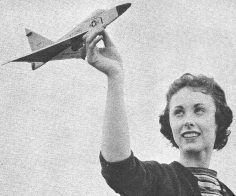 Conical camber shows in pic, drawings. If Miss Donna Hubbard seems to approve it's because she is an Aeronautical Engineering student at University of Minnesota [original caption] 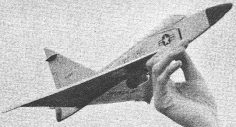 Detail showing ‘conically cambered’ leading edges curling down progressively toward tip 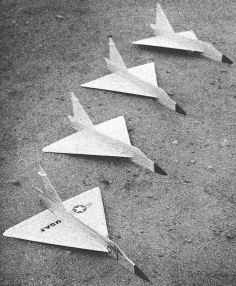 For quickie, make flat-wing version—two top models. Others use conical camber; leading edge curls down progressively toward tip [original caption]
- Model Airplane News, August 1959
|
|||
|
|
||||
|
|
|
|||
|
|
|
|
|
|
|
|
Acknowledgements - Article: Roger Simmonds - Illustrations: Roger Simmonds, Steve Bage, Ken Butterfield, MAAC archives via Bill Henderson, Mike Stuart |
|
|
|
|
ABOUT | MOTORS | MODELS | ARCHIVE | HISTORY | STORE | FAQ | LINKS |
|
|
Terms of Use
|
Queries? Corrections? Additions?
Please
contact us.
|
|